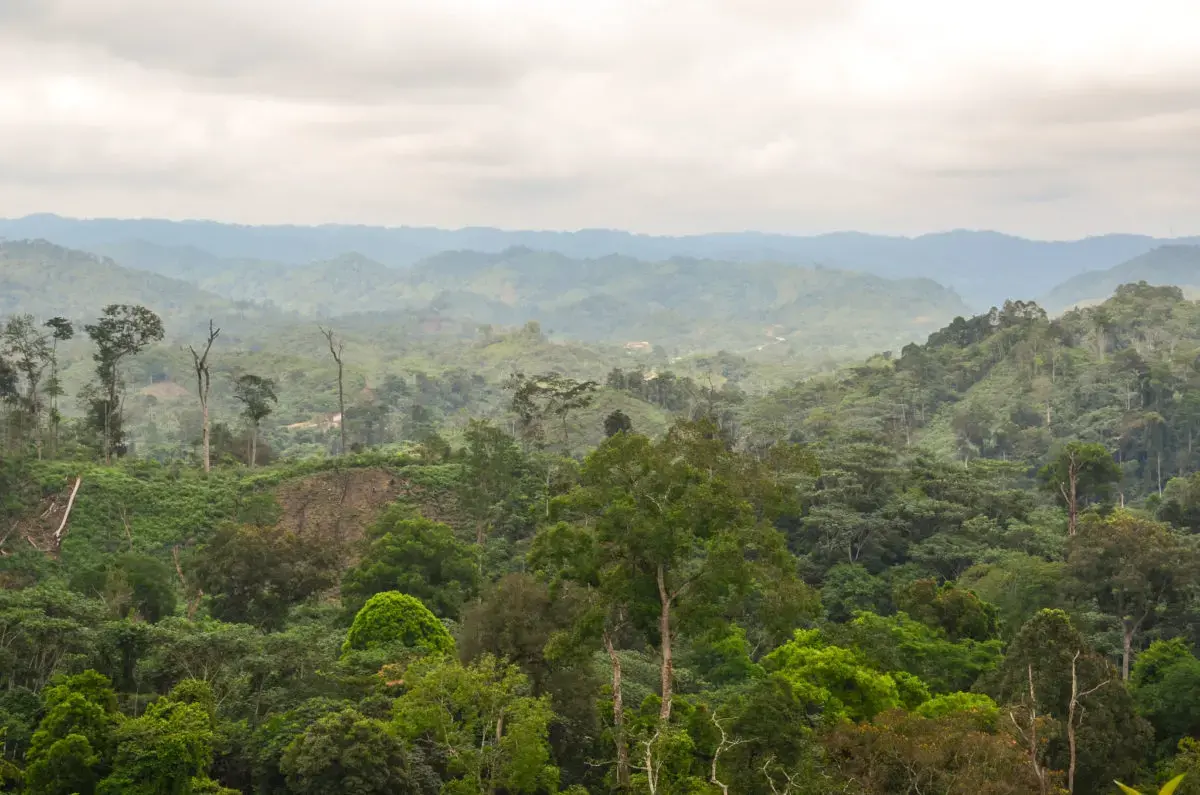This story was published by Farm Radio FM in English and in French. You may view the original story in French on the Rainforest Journalism Fund website here. Our website is available in English, Spanish, bahasa Indonesia, French, and Portuguese.

News Brief
The Mayombe forest is an important part of the Congo Basin, one of the world’s main ecological lungs. But the forest is gradually degrading because of fires set by farmers. Chimène Mahanga is a farmer in the nearby village of Kissila. She says: “We’re not arsonists. … These fires only appear between August and October. After clearing and felling, we proceed to burn the dead grasses and felled trees. It's to make the soil more fertile.” Slash-and-burn agriculture has been practiced in Mayombe for centuries, even millennia, as in most tropical forests. But now, population pressure means that the practice is becoming more dangerous. Meeting for Peace and Human Rights is raising awareness among farmers about how slash-and-burn agriculture is destroying the Mayombe forest. Other local organizations are working to help farmers learn alternatives to slash-and-burn agriculture, including how to cultivate crops that can grow in the shade of trees.

As a nonprofit journalism organization, we depend on your support to fund journalism covering underreported issues around the world. Donate any amount today to become a Pulitzer Center Champion and receive exclusive benefits!
The Mayombe forest is an important part of the Congo Basin, one of the world’s main ecological lungs. But the forest is gradually being destroyed. Thick columns of smoke and flames consume the trees and skies. And local farmers say there is a reason for the situation.
Chimène Mahanga is a farmer in the nearby village of Kissila. She says: “We’re not arsonists. What pleasure would we find in burning the forest? These fires only appear between August and October. After clearing and felling, we proceed to burn the dead grasses and felled trees. It’s to make the soil more fertile.”
He’s correct. After the fires are extinguished, the soil is covered with ash that contain mineral salts that promote the growth of crops such as cassava, banana, taro, and yam.
But the practice seems to run counter to ideas about sustainability. After harvesting, the soil must be left fallow and the farmer must harvest another plot of forest. In the case of cassava, the fallow period lasts around a year. It takes more than a decade for the soil to become fertile again and nearly a quarter of a century for the dense forest to fully recover.
As in most tropical regions, slash-and-burn agriculture has been practiced in Mayombe for centuries, even millennia, as in most tropical forests. But now, population pressure means that the practice is becoming more harmful.
Michel Ngoma is a farmer from Doumanga. He says: “By creating very small farms, intended for self-consumption, slash-and-burn agriculture was [once] the way for us to exploit our forest in a sustainable way. But lately, many people from other places have arrived in Mayombe. And they are exploiting very large areas. One person alone can have more than 50 hectares.”
Since the RN1 road connecting Pointe-Noire to Brazzaville opened in 2011, agriculture seems to have intensified in the region.
It’s a situation that Mr. Ngoma fears. He says, “At this rate, we risk running out of land one day.”
Fabrice Séverin Kimpoutou is a research officer with the Meeting for Peace and Human Rights, or RPDH. He agrees with Mr. Ngoma. Mr. Kimpoutou says: “Let’s take the example of Mossendjo (Editor’s note: A region in southwestern Congo). All around, there was dense forest. But because of the increase in population, slash-and-burn agriculture has intensified. And the dense forest no longer exists there—to the great displeasure of the farmers, who are sometimes forced to migrate in search of fertile land.”
And to prevent the Mayombe forest from suffering the same fate, Meeting for Peace and Human Rights is raising awareness among farmers.
Some local residents say they are already aware of the dangers of slash-and-burn agriculture.
Pascal Lebanda lives in Doumanga and has an orchard that contains avocado, mango, citrus, and pineapple trees.
He says, “As you can see, we do not practice slash-and-burn agriculture. We are just clearing the land. Once the clearing is done, we let the grass rot. This creates food for the plants.”
But he notes that this approach isn’t as successful for farmers who grow other kinds of crops. He explains: “It is difficult to extend these practices throughout Mayombe because here, people rely much more on cassava, which can be harvested more quickly than fruit trees.”
To meet the needs of these farmers, Meeting for Peace and Human Rights plans to call on specialists for training. Mr. Kimpoutou says, “We will hire the services of experts in agronomy, for example, to provide farmers with the training they need to adopt other sustainable farming techniques.”
While waiting for these trainings, other NGOs are already thinking of alternatives. Crépin Télinganou is a graduate in tropical agriculture and the president and founder of the National Agropastoral and Environmental Network. He says: “It is possible to cultivate in a forest without burning or cutting down trees. This is the case for coffee and cocoa trees, which can grow and germinate under the shade of other trees. On the other hand, cassava, which is the staple food in the Congo, cannot grow in the shade of trees.”
But, he adds: “In the savannah, we can easily practice agriculture without burning. In the savannah, after clearing the land, grass is ploughed into the soil and … crops such as cassava and yam are grown. As for crops such as groundnuts, we plow and sow.”
Mr. Télinganou says that alternative ways of farming are necessary to save the Mayombe forest and provide for local farmers. He adds, “Education, awareness-raising, and training sessions are needed for the farmers of Mayombe to reduce or stop using slash-and-burn agriculture.”



